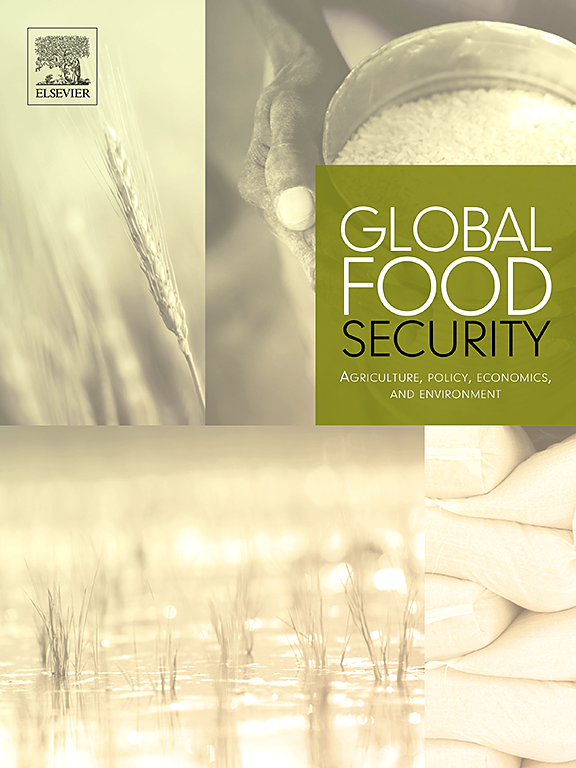How does migration affect the food security and health of children and adults ?
IF 9.6
1区 经济学
Q1 FOOD SCIENCE & TECHNOLOGY
Global Food Security-Agriculture Policy Economics and Environment
Pub Date : 2025-08-12
DOI:10.1016/j.gfs.2025.100879
引用次数: 0
Abstract
Food security and nutrition are crucial for well-being and global development, as emphasized by Sustainable Development Goal 2. Nevertheless, low- and middle-income countries (LMICs) continue to face significant challenges related to food insecurity and malnutrition, adversely affecting health throughout the life course—from impaired child development to increased risks of non-communicable diseases in adults. Meanwhile, international migration has emerged as a key livelihood strategy in these regions. While research has explored migration's impact on household well-being, its complex interactions with food security, nutrition, and health across different household members remain underexplored. This study investigates how international migration affects the food security, nutrition, and health of left-behind households in rural Tajikistan. Using a large-scale dataset of 10,742 households and an instrumental variable approach, we find that migration significantly enhances food purchasing power, increases macronutrient intake, and improves diet quality and quantity. While children's health outcomes improve, the incidence of diet-related chronic diseases among adults rises. We also identify nonlinear relationships between migration duration and calorie intake (inverted U-shaped) and the General Dietary Quality Score (U-shaped), reflecting patterns observed in adult hypertension. These findings suggest that Tajikistan and other LMICs should implement policies to promote employment opportunities for rural households to improve food security and nutrition. Additionally, targeted interventions are necessary to ensure balanced nutrition and health education for migrant-sending communities and households with migrants.
移徙如何影响儿童和成人的粮食安全和健康?
正如可持续发展目标2所强调的那样,粮食安全和营养对人类福祉和全球发展至关重要。然而,低收入和中等收入国家继续面临与粮食不安全和营养不良有关的重大挑战,对整个生命过程的健康产生不利影响——从儿童发育受损到成人非传染性疾病风险增加。与此同时,国际移民已成为这些地区的一项关键生计战略。虽然研究已经探讨了移民对家庭福祉的影响,但其与不同家庭成员之间粮食安全、营养和健康的复杂相互作用仍未得到充分探讨。本研究探讨国际移民如何影响塔吉克斯坦农村留守家庭的粮食安全、营养和健康。利用10,742个家庭的大规模数据集和工具变量方法,我们发现迁移显著提高了食品购买力,增加了宏量营养素的摄入量,并改善了饮食质量和数量。虽然儿童的健康状况有所改善,但成年人中与饮食有关的慢性病的发病率却在上升。我们还确定了迁移时间与卡路里摄入量(倒u形)和一般饮食质量评分(u形)之间的非线性关系,反映了在成人高血压中观察到的模式。这些研究结果表明,塔吉克斯坦和其他中低收入国家应实施政策,促进农村家庭就业机会,以改善粮食安全和营养。此外,有针对性的干预措施是必要的,以确保向移徙者派遣社区和移徙者家庭提供均衡的营养和健康教育。
本文章由计算机程序翻译,如有差异,请以英文原文为准。
求助全文
约1分钟内获得全文
求助全文
来源期刊

Global Food Security-Agriculture Policy Economics and Environment
FOOD SCIENCE & TECHNOLOGY-
CiteScore
20.90
自引率
3.40%
发文量
69
期刊介绍:
Global Food Security plays a vital role in addressing food security challenges from local to global levels. To secure food systems, it emphasizes multifaceted actions considering technological, biophysical, institutional, economic, social, and political factors. The goal is to foster food systems that meet nutritional needs, preserve the environment, support livelihoods, tackle climate change, and diminish inequalities. This journal serves as a platform for researchers, policymakers, and practitioners to access and engage with recent, diverse research and perspectives on achieving sustainable food security globally. It aspires to be an internationally recognized resource presenting cutting-edge insights in an accessible manner to a broad audience.
 求助内容:
求助内容: 应助结果提醒方式:
应助结果提醒方式:


